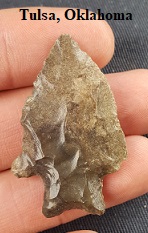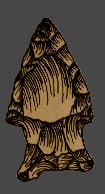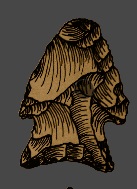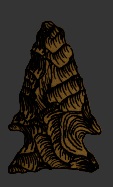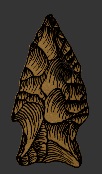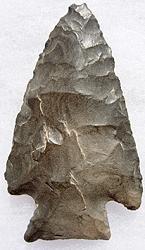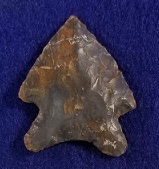Outline is Representative of Size and Shape:
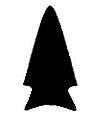
Name Details:
Identified By: Dee Ann Suhm, Alex D. Krieger, Edward B. Jelks
Named For:
Date Identified: 1954
Type Site:
Identified By: Dee Ann Suhm, Alex D. Krieger, Edward B. Jelks
Named For:
Date Identified: 1954
Type Site:
Point Validity:
Valid type
Suhm was an eminent Texas anthropologist who, among many distinguished positions, served as Director of Texas Archaeological Research Laboratory. Krieger was a renowned anthropologist who spent most of his career in Texas cataloging projectile points and pottery in Texas before moving on to the University of Washington. Jelks was a distinguished anthropologist and helped organize the newly formed Department of Anthropology at Illinois State University where he was a Professor. His work in Texas furthered the understanding of Texas archeology and was a founding force for the Society of Historical Archeology. This point was named in a professional publication and has many professional references. This is a valid type.
Suhm was an eminent Texas anthropologist who, among many distinguished positions, served as Director of Texas Archaeological Research Laboratory. Krieger was a renowned anthropologist who spent most of his career in Texas cataloging projectile points and pottery in Texas before moving on to the University of Washington. Jelks was a distinguished anthropologist and helped organize the newly formed Department of Anthropology at Illinois State University where he was a Professor. His work in Texas furthered the understanding of Texas archeology and was a founding force for the Society of Historical Archeology. This point was named in a professional publication and has many professional references. This is a valid type.
Edgewood Expanding Stem
Cluster: Description of Physical Characteristics and Flaking Pattern:
This is a small to medium triangular expanding stem point with an elliptical cross section. The blade is short and may vary from straight to excurvate. The blade may exhibit beveling on the right-hand edge, or both edges. The shoulders are prominent and range from barbed to having an upward angle. The stem is expanding with the base usually being as wide as the shoulders. The base is most commonly concave, but may range to almost straight. This point has a random flaking pattern.
Size Measurements:
Length - 30 to 50 mm, Stem Length - 13 to 17 mm (typically makes up 1/3 to 1/2 the total length), Width - 20 to 30 mm, Stem Width - 15 to 20 mm (Suhm and Krieger, 1954)
Length - 30 to 50 mm, Stem Length - 13 to 17 mm (typically makes up 1/3 to 1/2 the total length), Width - 20 to 30 mm, Stem Width - 15 to 20 mm (Suhm and Krieger, 1954)
Commonly Utilized Material:
Additional Comments:
This type can be difficult to distinguish from the Fairland type which has similar distribution and time line. It is generally thought that these points are smaller (30 to 50 mm in length Fairland 41 to 70 mm in length) with the same width making them broader than the Fairland point. However, it has been argued that these two types may represent the same type. In examples provided by Suhm and Krieger (1954), they note that examples that they show for Edgewood points (plate 88) may contain Fairland points and examples provided for Fairland points (plate 91) may contain Edgewood points due to the difficulty distinguishing the two types. These points can also be difficult to distinguish from Bandy and Martindale point. This type may represent a catchall for outliers of these three types and not a true distinguishable type.
This type can be difficult to distinguish from the Fairland type which has similar distribution and time line. It is generally thought that these points are smaller (30 to 50 mm in length Fairland 41 to 70 mm in length) with the same width making them broader than the Fairland point. However, it has been argued that these two types may represent the same type. In examples provided by Suhm and Krieger (1954), they note that examples that they show for Edgewood points (plate 88) may contain Fairland points and examples provided for Fairland points (plate 91) may contain Edgewood points due to the difficulty distinguishing the two types. These points can also be difficult to distinguish from Bandy and Martindale point. This type may represent a catchall for outliers of these three types and not a true distinguishable type.
Distribution:

Distribution Comments:
This point is primarily found in southeastern Oklahoma, southwestern Arkansas, western Louisiana, and northeastern Texas. Frequency diminishes into central Texas. Rarely found into southern Texas, northeastern Coahuila, northern Nuevo Leon, and northern Tamaulipas.
This point is primarily found in southeastern Oklahoma, southwestern Arkansas, western Louisiana, and northeastern Texas. Frequency diminishes into central Texas. Rarely found into southern Texas, northeastern Coahuila, northern Nuevo Leon, and northern Tamaulipas.
Age / Periods:
Date: 3,000 - 1,500 B.P.
Cultural Period: Transitional Archaic to Early Woodland
Glacial Period: Neoglacial to Roman Warm
Culture:
Date: 3,000 - 1,500 B.P.
Cultural Period: Transitional Archaic to Early Woodland
Glacial Period: Neoglacial to Roman Warm
Culture:
Age Details:
Other points in this cluster / Related / Associated Points:

